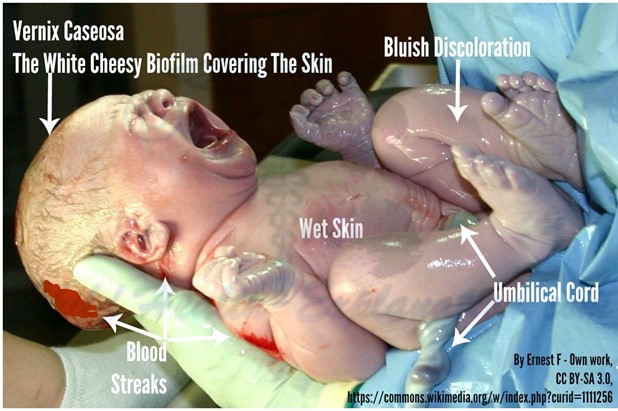The cheese-like, whitish substance that fuses with the epidermis and serves as a protective coating is called:
Vernix caseosa
Surfactant
Caput succedaneum
Acrocyanosis
The Correct Answer is A
Vernix caseosa is a cheese-like, whitish substance that fuses with the epidermis and serves as a protective coating for the newborn.

Some possible explanations for the other choices are:
- Choice B. Surfactant is a protein that lines the alveoli of the infant’s lungs and helps prevent them from collapsing.
- Choice C. Caput succedaneum is a swelling of the tissue over the presenting part of the fetal head caused by pressure during delivery.
- Choice D. Acrocyanosis is a bluish discoloration of the hands and feet due to reduced peripheral circulation.
Normal ranges for vernix caseosa are not applicable as it varies depending on the gestational age and skin maturity of the newborn. However, it is usually more abundant in preterm infants than in term or post-term infants.
Nursing Test Bank
Naxlex Comprehensive Predictor Exams
Related Questions
Correct Answer is D
Explanation
Therapeutic management includes the administration of gamma globulin and aspirin. This is because Kawasaki disease causes inflammation in the walls of small to medium-sized blood vessels that carry blood throughout the body and can lead to complications such as coronary artery aneurysms. Gamma globulin is an intravenous immunoglobulin that can reduce the risk of these complications, and aspirin can help lower fever and inflammation.
Choice A is wrong because the child’s fever is usually not responsive to antibiotics within 48 hours. Kawasaki disease is not caused by a bacterial infection, so antibiotics are not effective.
Choice B is wrong because the principal area of involvement is not the joints. Kawasaki disease affects mainly the blood vessels, but it can also cause swelling in glands (lymph nodes) and mucous membranes inside the mouth, nose, eyes and throat. Joint pain or swelling may occur, but it is not the main feature of the disease.
Choice C is wrong because aspirin is not contraindicated. Aspirin is part of the standard treatment for Kawasaki disease, along with gamma globulin. However, aspirin should be used with caution and under medical supervision, as it can cause Reye’s syndrome in children with viral infections.
Correct Answer is ["B","D"]
Explanation
Sleepiness or fatigue and puffiness around the eyes are symptoms associated with hypothyroidism. Hypothyroidism is a condition where the thyroid gland does not produce enough thyroid hormones, which regulate the body’s metabolism and energy levels.
Choice A is wrong because weight loss is more likely to occur in hyperthyroidism, a condition where the thyroid gland produces too much thyroid hormones.
Choice C is wrong because diarrhea is also more likely to occur in hyperthyroidism, as the excess thyroid hormones speed up the digestive system.
Choice E is wrong because limited hair growth is not a specific symptom of hypothyroidism. Hair loss or thinning may occur in both hypothyroidism and hyperthyroidism, depending on the severity and duration of the condition.
Normal ranges for thyroid hormones are:
- TSH: 0.4 to 4.0 mIU/L
- T3: 100 to 200 ng/dL
- T4: 4.5 to 11.2 mcg/dL
Whether you are a student looking to ace your exams or a practicing nurse seeking to enhance your expertise , our nursing education contents will empower you with the confidence and competence to make a difference in the lives of patients and become a respected leader in the healthcare field.
Visit Naxlex, invest in your future and unlock endless possibilities with our unparalleled nursing education contents today
Report Wrong Answer on the Current Question
Do you disagree with the answer? If yes, what is your expected answer? Explain.
Kindly be descriptive with the issue you are facing.
